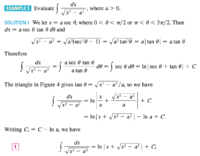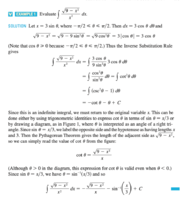You are using an out of date browser. It may not display this or other websites correctly.
You should upgrade or use an alternative browser.
You should upgrade or use an alternative browser.
In this problem, why is the interval for theta not [-pi/2,0) U (0,pi/2] instead?
- Thread starter 333happy
- Start date
skeeter
Elite Member
- Joined
- Dec 15, 2005
- Messages
- 3,204
Why are you concerned about [MATH]\theta[/MATH] ? But you are correct that [MATH]\theta\neq 0[/MATH]
probably because the given "solution" states [MATH]-\dfrac{\pi}{2} \le \theta \le \dfrac{\pi}{2}[/MATH], which should not include [MATH]\theta = 0[/MATH]
good catch, imo
Dr.Peterson
Elite Member
- Joined
- Nov 12, 2017
- Messages
- 16,873
This is not the entire solution, but just the beginning of the work. If they gave that interval as part of their final answer, it would be wrong, but I see nothing wrong in stating the substitution as they do, with the usual interval. Further restrictions can be added as they finish the work.View attachment 22110
For instance, if theta = 0, then x = 3sin0 = 0, and clearly the x^2 in the denominator of the integrand should not be equal to zero.
Would you like to show us the whole answer?

Could I ask about this, too? It's just that when I'm learning about trig substitutions, there isn't really any emphasis on what theta can take. For instance, if x=sec(theta), I am told that theta is usually in [0, pi/2) U (pi/2 , pi]. For this particular problem, I have the following questions:
1) Is the reason why they excluded 0 in (0, pi/2) so that asec(Theta) is never equal to a? Because sqrt(x^2-a^2) in the denominator of the integrand has to be nonzero, that is, x^2-a^2>0. From this,
x<-a or x>a
a sec(Theta)<-a or a sec(Theta)>a
-pi/2 < x < 0 or 0 < x < pi/2
2) Should the interval only be 0 < x < pi/2 instead of the one given in the problem? Because I noticed that from x = a sec(theta), they got arcsec(x/a) = arcsec(sec(theta)) = theta. But arcsec(sec(Theta))=theta for only values of theta between 0 and pi. so we can't have vlaues of theta between pi and 3pi/2.

This is not the entire solution, but just the beginning of the work. If they gave that interval as part of their final answer, it would be wrong, but I see nothing wrong in stating the substitution as they do, with the usual interval. Further restrictions can be added as they finish the work.
Would you like to show us the whole answer?
this is the entire solution for the problem. would you now say it's wrong because of the interval of theta? do i stick with excluding 0?
Dr.Peterson
Elite Member
- Joined
- Nov 12, 2017
- Messages
- 16,873
As I suggested, the interval [-pi/2, pi/2] is there just to define the substitution, not as part of the final answer. It is simply the domain of the inverse sine, chosen so that theta is uniquely defined, and so that the sign of the cosine can be determined. There is nothing wrong with that. Saying that theta is restricted to be within a certain interval does not mean that every such value is valid, any more than saying that you must be over 4 feet tall to participate in an event implies that anyone 9 feet tall has ever done so.View attachment 22132
this is the entire solution for the problem. would you now say it's wrong because of the interval of theta? do i stick with excluding 0?
When they later find an expression for cot(theta), they note that it is appropriate for positive or negative theta [without needing to remind us that not all positive or negative numbers are allowed), implicitly noting that it is not applicable for zero theta. Then they apply the inverse sine, which they can do because of the restriction. At no point are they claiming that theta is ever actually zero.
I can't tell you why they didn't include 0 and pi, as I would normally do based on [one version of] the range of the inverse secant. You'd have to ask them! It may be, as you suggest, that this time they did look ahead and see that those values would not be needed, or it could be a typo!View attachment 22128
Could I ask about this, too? It's just that when I'm learning about trig substitutions, there isn't really any emphasis on what theta can take. For instance, if x=sec(theta), I am told that theta is usually in [0, pi/2) U (pi/2 , pi]. For this particular problem, I have the following questions:
1) Is the reason why they excluded 0 in (0, pi/2) so that asec(Theta) is never equal to a? Because sqrt(x^2-a^2) in the denominator of the integrand has to be nonzero, that is, x^2-a^2>0. From this,
x<-a or x>a
a sec(Theta)<-a or a sec(Theta)>a
-pi/2 < x < 0 or 0 < x < pi/2
2) Should the interval only be 0 < x < pi/2 instead of the one given in the problem? Because I noticed that from x = a sec(theta), they got arcsec(x/a) = arcsec(sec(theta)) = theta. But arcsec(sec(Theta))=theta for only values of theta between 0 and pi. so we can't have values of theta between pi and 3pi/2.
Your second question suggests that you are using a different range for arcsec. There are at least two common choices, and it looks to me like they are using [0, pi/2) U [pi, 3 pi/2) rather than what you suggested, [0, pi/2) U (pi/2 , pi]. You should look up their definition; this choice is common in calculus because it makes the derivative simpler (because the tangent is positive). I discussed this in my blog here. It's also possible that they don't use this as the range of arcsec, but do use it as standard in this substitution because of this benefit. Maybe they mention that elsewhere.
You're probably right that details about intervals for theta are too often ignored, so you are right to be paying close attention to them; your source is being very careful, but perhaps should be explaining a little more (or perhaps did earlier, and doesn't want to repeat it all too often).
